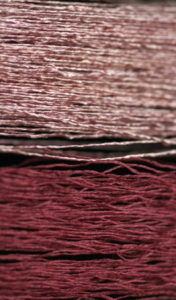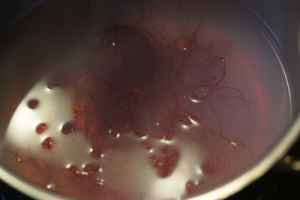Search the Blog
Latest Comments
Gummy Silk - The Adventure Goes On.
First of all, here's a better picture of the two silks side by side:

Now to the answers to all the comments yesterday...
Jessica's comment was:
That's really interesting! And it probably explains the deep colours we see in medieval embroidery. And how they were able to do couching over padding with a relatively thin thread and still being able to force the gold threads into place and keep them there. How does this partly gummed silk compare to modern Chinese flat silk? That's my go-to silk for medieval projects as it produces embroidery with a slight wavey texture as seen in medieval embroidery.
I wrote an article a while ago where I came upon twisted medieval silk. This is from my article:Lisa Monnas and Roberta Orsi Landini wrote on S-twisted silk threads: ´fourteenth-century velvets usually have Z-spun main ends…but from the late 1420s their [i.e. Italian velvets] main warp threads were generally S-twisted. In contrast Ottoman velvets of the late 15th and 16th centuries generally have Z-twisted main warp threads´ (Monnas 2012, 15); ‘the finest silk thread was used for the warp: strong shiny silk organzine, generally made up of 2 S-twisted ends’ (Orsi Landini 2017, 15-16).Monnas, L. (2012) Renaissance velvets. London: V&A Publishing.Orsi Landini, R. (2017) The velvets in the collection of the Costume Gallery in Florence / I velluti nella collezione della Galleria del costume di Firenze. Riggisberg and Florence: Edizioni Polistampa.So even reeled silk seems to have been twisted - at least a bit.
Finally, Florence asked:
How does one de-gum silk?There's several different ways to do it; you can read more about how the process works here (where different methods used in the industry are given).
The classical method is to boil it off with soap, typically Marseille soap, which is based on olive oil. Which is also what I used for the de-gumming test I did today with a bit of the Texel silk.
[caption id="attachment_6739" align="alignnone" width="300"]
 During the de-gumming process - it's starting to lose some of the colour to the soap soup.
During the de-gumming process - it's starting to lose some of the colour to the soap soup.It's hanging out to dry right now, so proper colour comparison may only come later. I'm just as curious as you are!
Comments 2
Thank you so much for your explanations! I have just ordered some of the silk . As I am planning on seeing some medieval embroideries up close soon, I will take the spool with me and compare. And I will be doing a few experiments with it too. Yes, Chinese flat silk does like to snag. However, when you use it regularly, it does hardly snag. It has all to do with tension. In my experience, each stitcher has a different coping mechanism. I let my working thread run over my index finger.
When I compare your coloured embroidery silks with the Chinese flat silk, they seem different. But this might be due to spooling. The Chinese silk comes as a bundle and is loosely two-ply. Let me know if you would like a sample for comparison!
Thank you - and I hope you'll have fun and success using it!
When I'm working with the flat silk, I don't have as much of a snagging issue, but a lot of my pieces are "in-progress" demo things that I carry around and show to people to explain things... and the threads hanging out there are, hm, let's say they are not looking their best anymore. I like the "coping mechanism" thought, though! And thinking of it, yes, I think I also keep tension on the thread while working, and that definitely helps.
A sample of the Chinese silk would be very welcome!



